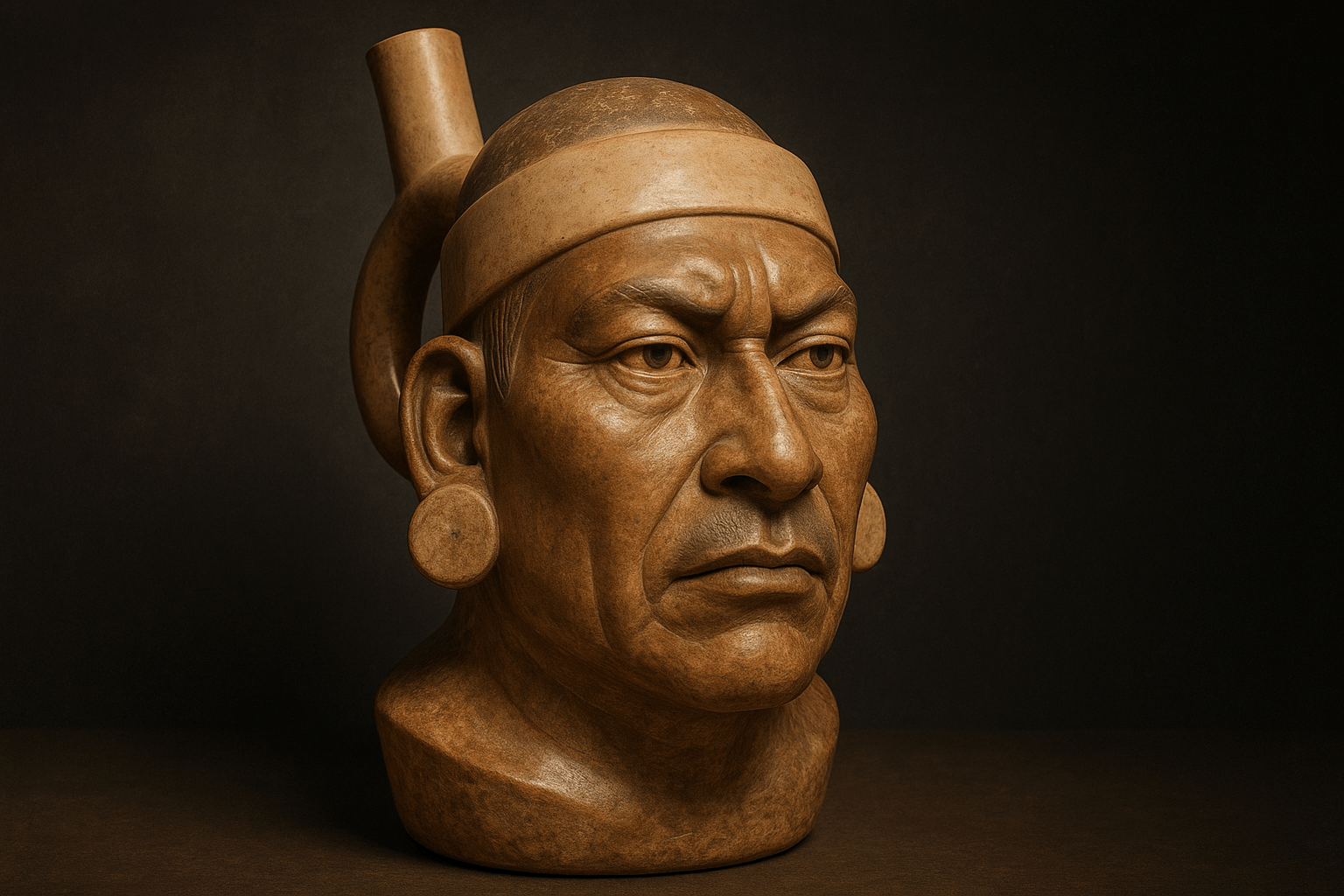Masters of a Harsh Land
Flourishing from roughly 100 to 800 CE, the Moche civilization was not a unified empire but rather a collection of autonomous polities that shared a common culture, religion, and artistic style. They were masters of hydraulic engineering, constructing an intricate network of canals to divert river water across vast distances. This monumental effort transformed the desert into a fertile agricultural breadbasket, supporting a dense population and allowing their complex society to thrive. Their ability to tame such an unforgiving environment was central to their power and, as we’ll see, a potential key to their ultimate downfall.
The Adobe Mountains: Huaca del Sol and Huaca de la Luna
The most visible legacy of Moche power are their monumental temples, or huacas. The two most famous are the Huaca del Sol (Temple of the Sun) and Huaca de la Luna (Temple of the Moon) in the Moche Valley. The Huaca del Sol was once the largest adobe structure in the Americas, a colossal man-made mountain built from an estimated 140 million mud bricks. Though heavily eroded by time and plundered by Spanish conquistadors who diverted a river to wash it away in search of gold, its sheer scale is still staggering.
Across the plain stands its partner, the Huaca de la Luna. While smaller, it is far better preserved, revealing the true purpose of these centers. Archaeologists have uncovered multiple layers of construction, as the Moche periodically buried old temples and built new ones on top. Its interior walls are a spectacle of vibrant murals painted in red, yellow, black, and white, depicting a fearsome fanged deity, warriors, captured prisoners, and complex mythological scenes. This was not just a temple; it was a center for political administration, elite burials, and terrifying ceremony.
A Society Written in Clay
Perhaps the Moche’s most enduring gift to history is their pottery. Lacking a writing system, they used ceramics as their textbook, their canvas, and their library. Moche potters created stunningly realistic and expressive works that provide an unparalleled window into their world. Their famous “portrait heads” are not generic representations but lifelike depictions of specific individuals, complete with wrinkles, scars, and distinct personalities. You feel as if you are gazing into the face of someone who lived nearly two millennia ago.
Beyond portraits, their distinctive stirrup-spout vessels—so named for the handle’s resemblance to a stirrup—depict an incredible array of themes:
- Daily Life: We see women weaving textiles, men fishing in reed boats, and healers tending to the sick.
- Warfare: Warriors adorned in elaborate regalia, complete with nose ornaments and fearsome helmets, are shown battling with maces and shields.
- Mythology: Anthropomorphic creatures, from crab-men to bird-warriors, act out complex narratives that are still being deciphered by scholars.
- Ritual Sacrifice: In chilling detail, scenes show the arraignment of naked prisoners, their execution, and the presentation of their blood in goblets to priest-kings.
This ceramic record is so rich that it has allowed archaeologists to reconstruct vast swathes of Moche society, from their social hierarchy to their religious beliefs.
The Gleam of Gold and the Lord of Sipán
The Moche were also master metallurgists, skilled in working with gold, silver, and copper. They perfected techniques like depletion gilding to create objects that appeared to be solid gold. For decades, the best examples of this work were seen only in museums, looted from graves by treasure hunters. That all changed in 1987 with one of the most important archaeological discoveries of the 20th century: the tomb of the Lord of Sipán.
Accidentally discovered by looters but secured by Peruvian archaeologist Walter Alva, this unplundered royal tomb revealed the breathtaking wealth and power of a Moche ruler. The Lord was buried in a wooden coffin surrounded by treasure and sacrificial retainers. He was adorned with spectacular gold and turquoise ear spools, a golden face mask, intricate beaded pectorals, and phenomenal golden headdresses. The craftsmanship was exquisite. Buried with him were other individuals—guards, wives, and servants—intended to accompany him into the next world. The discovery was the American equivalent of opening King Tut’s tomb, proving that the high-status figures depicted on Moche pottery were real, powerful lords who commanded immense resources and held the power of life and death.
A Civilization Undone by Climate
For centuries, the Moche elite ruled from their huacas, overseeing a prosperous and highly structured society. Their authority was likely tied to their perceived ability to mediate with the gods to ensure agricultural fertility. But around 600 CE, something went terribly wrong.
The leading theory for the Moche collapse points to a catastrophic series of climate events. Ice core data from the Andes suggests that the 6th and 7th centuries were a period of extreme weather volatility. Archaeologists believe the Moche were hit by a “mega El Niño” event that lasted for over 30 years, bringing torrential rains and catastrophic flooding that would have washed away their fields and destroyed their critical canal systems. This period of flooding was then followed by an equally devastating, decades-long drought.
Faced with starvation and a world turned upside down, the Moche people would have lost faith in their leaders. The rituals and sacrifices, meant to appease the gods, had failed. Evidence from the Huaca de la Luna shows a final, desperate-looking phase of mass human sacrifice, a last-ditch attempt to restore balance. When it didn’t work, the social fabric unraveled. The great centers were abandoned, and the Moche civilization fragmented and faded, eventually giving way to new cultures like the Chimú, who would later be conquered by the Inca.
The Moche may be a “forgotten” civilization, overshadowed by their more famous successors. But their legacy, preserved in mud-brick and fired clay, tells a powerful story of innovation, artistry, and the profound fragility of human society in the face of a changing climate—a lesson that resonates as strongly today as it did 1,500 years ago.
